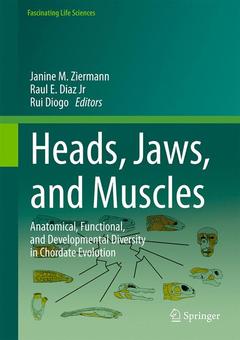Heads, Jaws, and Muscles, 1st ed. 2019 Anatomical, Functional, and Developmental Diversity in Chordate Evolution Fascinating Life Sciences Series
Coordonnateurs : Ziermann Janine M., Diaz Jr Raul E., Diogo Rui

- Janine M. Ziermann: Howard University College of Medicine, Dept. Anatomy,
- Rui Diogo: Howard University College of Medicine, Dept. Anatomy,
- Raul E. Diaz Jr.: La Sierra University, Dept. Biology;
Why is this book interesting for a broad audience?
- Presenting, some extreme cases of heads:
o size: elephant – largest land mammal, blue whale – largest mammal in general; Paedophryne amauensis – smallest vertebrate and smallest amphibian; smallest fish is Paedocypris progeneticao feeding adaptations:
§ filter feeder (e.g., amphioxus, most forage fish, baleen whales, flamingos)§ herbivores, carnivore, omnivore (e.g., giraffe, lion, bear; or cow, alligator, rhea)
§ microphagues, megalophagues (e.g., filter feeders vs. Lepidobatrachus – can eat prey its own size!)- Diversity of not only feeding modes but also sensory adaptations (e.g., large orbits for nocturnal or deep see specimens)
- All vertebrates are linked – evo-devo!o recent discoveries show that some developmental mechanisms are conserved from earliest chordate to humans (e.g., cardiopharyngeal field)
- This book is for everyone that has interest in the diversification, evolution and development of “Heads, Jaws and Muscles”.
o Present idea about emergence of new head at end BUT with Amphioxus and urochordates having already many components of vertebrate head, such as branchiomeric muscles, gills in amphioxus, etc.
o So emerging question (for the purpose of the story) Where / When did the head evolve? Include fossils, etc.Chapters
1. Cephalochordates –Daniel Aldea, Stephanie Bertrand & Hector Escriva
UPMC Univ Paris 06, UMR 7232, BIOM, Observatoire Océanologique de Banyuls sur Mer
- Amphioxus already has a head (branchiomeric) muscles and other head structures (gills etc.)
- refer to recent studies of muscle development of Yasui et al., of Hector's team on anterior somites, etc.
- Urochordates closest relatives to vertebrates
- What do they teach us about evolution and development in vertebrates? cardiopharyngeal field, etc.
- What are the main “innovations” towards vertebrates, and then towards gnathostomes?
- Summary of fossils, etc.
- Where did the jaw come from? Fossils and associated muscles, etc.Transitions to vertebrates, including fossils? –
- Cyclostomes – Janine Ziermann; Howard University College of Medicine, Dept. Anatomy)
- Ziermann & Diogo's suggested ideas to head/neck muscle evolution in cyclostomes and compared to gnathostomes inferred plesiomorphic muscle repertoire
- Miyashita's idea about derived similarity of mandibular and other branchial arches
- Chondrichthyans - Peter Johnston; Department of Anatomy with Radiology, University of Auckland & Catherine Boisvert; Australian Regenerative Medicine Institute (ARMI), EMBL Monash University
- What makes them so special?
- Actinopterygians – Allesia Huby & Eric Parmentier; Laboratoire Morphologie Fonctionnelle et Evolutive Institut de Chimie
- Actinopterygians are the most diverse vertebrates, diverse – some with highly specialized heads and jaws and associated muscles
- Sarcopterygians - Alice Clement; Flinders University, Biological Sciences
- Adaptations that come in handy for water-land-transition? Focus on head/neck and head/neck muscles.
- Include transition to tetrapods Amphibians – Janine Ziermann; Howard University College of Medicine, Dept. Anatomy
- Present diversity of head / neck structures as adaptation to feeding types, size, and/or other factors
- First on land – “challenges” with new environment (holding head above ground – neck; feeding – jaw musculature”)
- Specializations: biphasic lifestyle vs. direct development; burrowing (Gymniophiona) vs. diversity in salamander and frogs
- Present diversity of head / neck structures as adaptation to feeding types, size, and/or other factors
- How to turtles contribute to the understanding of head / head muscle development and evolution?
- Present diversity of head / neck structures as adaptation to feeding types, size, and/or other factors
- Archosaurs (Crocodylians and Aves, Dinosaurs) – Arkhat Abzhanov; Natural History Museum, Cromwell Road, London
- Present diversity of head / neck structures as adaptation to feeding types, size, and/or other factors Include dinosaurs’, particularly comparing their heads/jaws with crocodilians and birds, and including head/jaw muscles if possible
- Mammals, incl. Primates and Humans – Rui Diogo;Howard University College of Medicine, Dept. Anatomy
- Major innovations related to transition to mammals – licking, suckling, closure of post-orbital foramina due to growth of sphenoid bone – resulting changes in musculature? General development of mammalian muscles, based on mice
- Include human birth defects of the head
Conclusions/summary/outlook: Ziermann, Diogo, Diaz Conclusion
- Summary
- Major open questions that are currently under investigation
- Where to go from here: Outlook
Broadens your understanding on the origin of the vertebrate head
Provides a unique multidisciplinary coverage of the “Heads, Jaws and Muscles”, their evolution, and diversification among chordates
Written in a fluid, easy-to-understand way for both the scientific community as well as biology enthusiasts
Date de parution : 02-2019
Ouvrage de 303 p.
17.8x25.4 cm
Disponible chez l'éditeur (délai d'approvisionnement : 15 jours).
Prix indicatif 105,49 €
Ajouter au panierThèmes de Heads, Jaws, and Muscles :
Mots-clés :
vertebrate head; feeding modes; origin of the head; chordate; vertebrate jaw; head diversity; head evolution
Ces ouvrages sont susceptibles de vous intéresser

VertebratesStructures and Functions 220,72 €


